Blackbeard was outnumbered, and massively so. His reckless nature had taken over, and it had sent him leaping into the jaws of death. He had boarded a rival sloop with a handful of his loyal men, but now he could see none of them past the surrounding enemies. The deck on which he stood was slick with blood, some of it his rivals’, and some of it his own. He had already been hacked, slashed and shot, but still, somehow, he was standing. He was a terrifying vision on the deck, his wounds bleeding out and the smoke of gunpowder all about him as he heaved and gasped for breath. The men were hesitant, but confident in their numbers. They finally had him, trapped like a wild animal, the figure of legend and terror of the seas – not a demon, but a real man who could bleed and die.
The name Blackbeard holds great power, even today. The most feared and reviled pirate of his time, to us he is a figure obscured by myth and legend. To find out information about his early life is like chasing a shadow, a dark, long cloaked figure glimpsed in a gloomy alley, who vanishes through the fog. We are not even completely sure what his true name was. Most sources claim it was some variation of Edward Teach or Edward Thatch, while another claims it was Drummond, but none of these are verified, and are never likely to be confirmed. There’s plenty that could be true of the mysterious figure: he might have been born in Bristol, perhaps he was wealthy; both educated guesses based on what we know of the era, but neither are fact.
How can one man hide so well from history? How can a man, with a name so well known, hide from his past even today? The reason is simple: this was Blackbeard’s plan all along. Like many pirates, he did not wish to darken his family name, but even more so, what he desired was to create a fearsome image of himself. A backstory can serve to humanise a person, steeping them in reality, but he didn’t wish to be part of reality at all, instead painting himself as a figure of legend, of horror and of the unknown.
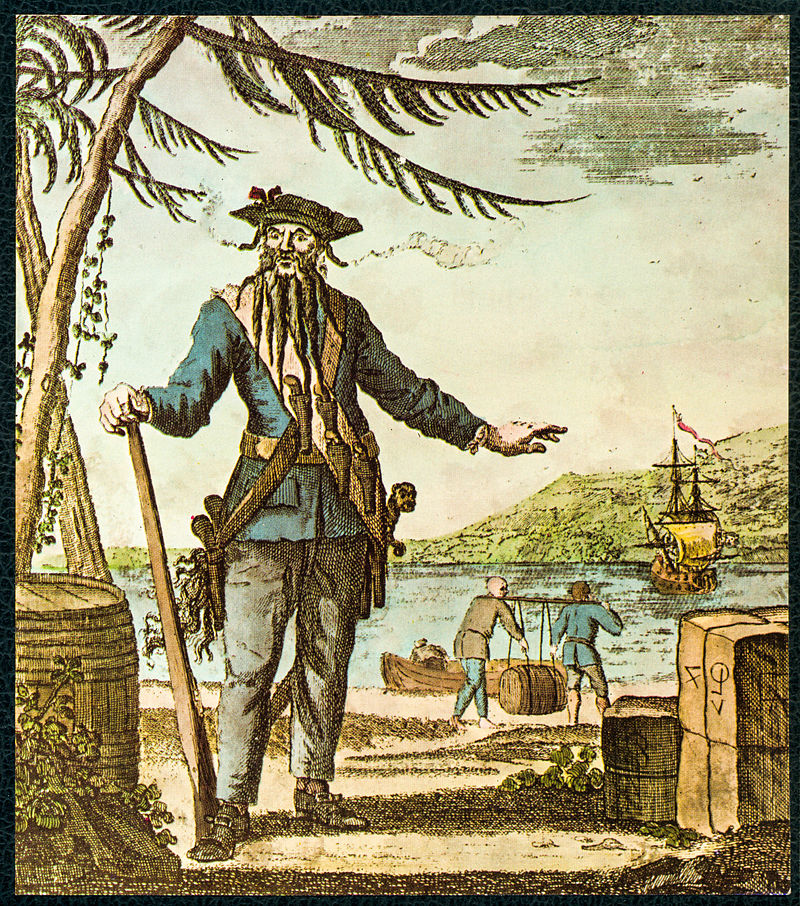
Colourised engraving of the man himself, c.1736
Blackbeard appears, seemingly out of nowhere around 1717, after likely serving as a privateer during Queen Anne’s War. At this point, he moved to New Providence in the Bahamas, and there joined the crew of a certain Captain Benjamin Hornigold, a privateer-turned-pirate who had made an infamous name for himself. Hornigold, not an easy man to impress by any means, must have seen some potential in Blackbeard as he put him in charge of a sloop he had captured. Now with Blackbeard in command of his own vessel and small crew, the two men set out pillaging and plundering many ships they encountered, their fearsome reputation was formed in this short period.
However, Hornigold was a man of morals, he wished to only attack enemy ships, and was against plundering British-flag vessels, despite the valuable booty they carried. His crew found this frustrating and after a vote, he was demoted from Captain. As second-in-command, this left Blackbeard in charge of one of the most feared forces of the seas. He, unlike Hornigold, had no objections to looting any ships, even those of his own countrymen. Hornigold soon retired, though would later begin a career as a pirate hunter, and Blackbeard found himself in charge of two powerful ships, a loyal crew, and with an insatiable appetite for riches and adventure.
Later that year, Blackbeard and his crew sailed the Eastern Caribbean and encountered a slave ship know as La Concorde. This huge French vessel would make a fine prize and, after Blackbeard fired two broadsides into it, the ship and crew surrendered. Blackbeard quickly made the vessel his flagship and fitted it out with 40 guns. He named it Queen Anne’s Revenge, perhaps in reference to the war he had most likely fought in (although, as with many of Blackbeard’s decisions, we cannot be certain of the true reasoning). One thing was for sure, though: he understood the importance of size and power on the ocean. The 40 guns were not necessarily for the purpose of devastating enemy ships, for he wouldn’t wish to sink them, but instead, to present a formidable, unbeatable sight to deter any rivals that dare contemplate facing him.
Blackbeard understood the incredible power of image very well, and he extended this not only to his ship, but to himself, too. He desired to strike fear into the heart of his enemies before even raising a weapon. As a naturally tall, broad man, he used this to his advantage, dressing himself in knee-high boots, dark clothing and a flaming red coat. To make himself even more imposing, he wore a wide hat. His famous thick black beard was long and braided with ribbons. He was later described as “such a figure that imagination cannot form an idea of a fury from Hell to look more frightful.” It must have been terrifying for those sailors, hearing tales of such a beast, to see his standard flying on an approaching ship, and the monster himself standing on deck, leering down upon them. It is no wonder that on many occasions, ships simply surrendered to him without a fight.
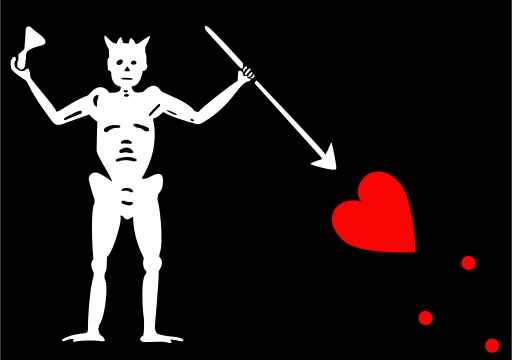
Blackbeard’s flag, which features a skeleton spearing a heart, and toasting the Devil at the same time
There were, in fact, far more fearsome pirates than Blackbeard, and some of these were vicious men who killed without mercy and committed horrific atrocities to the men they captured. Blackbeard never murdered or harmed anyone he held captive. All things considered, he was actually a more reasonable man than most of his rivals, but his fearsome appearance and reputation preceded him, and that was just how he liked it. Blackbeard’s actions actually prove how clever and cunning he could be. While sailing with Hornigold, Blackbeard met Stede Bonnet. This wealthy landowner spontaneously decided to become a pirate and had purchased his own ship to embark on adventures. Blackbeard quickly realised how unsatisfied his 70-man crew was with his weak command so, simply by asking nicely, he took control of his ship and crew. Bonnet, meanwhile, was kept along as a sort of upper-class traveller. Blackbeard understood the power the combined force would offer, and also the advantage of having a wealthy, naïve gentleman as a ‘friend.’
It was a most unlikely partnership but it worked, and Blackbeard with Bonnet in tow cruised the Caribbean, plundering and claiming whatever booty they could find, growing their fleet rapidly. Blackbeard looted his way from St Vincent to St Lucia, Nevis to Antigua and eventually ended up in Puerto Rico. Few ships dared to put up a fight or say no, partly due to the growing size of Blackbeard’s fleet, and mostly because of his grisly reputation. In 1718 the pirates had reached the Turneffe Islands in the Bay of Honduras, where they spotted the Jamaican sloop Adventure. The captain, David Herriot was ‘invited’ to join Blackbeard’s fleet and he accepted, likely terrified of doing anything to dismay the intimidating pirates, and another formidable ship was added to the flotilla.
The journey of terror and plunder continued as they sailed the Bay of Honduras where Blackbeard added a further four sloops and one ship to his fleet. He, at this point, likely felt indestructible. He took advantage of every ship and every opportunity he could, he knew a reputation was a powerful thing and in the space of a year, he had built one that few would manage to craft in a lifetime. This reputation was necessary, for Blackbeard was building up to his biggest and most brazen move yet.
In May 1718 the fearsome fleet of Queen Anne’s Revenge and three other sloops arrived off the port of Charles Town, South Carolina. This wasn’t a sail-by looting, or a quick getaway mission; instead, Blackbeard blockaded the entire port. The town had no guard ship and Blackbeard took advantage of this, stopping ships from attempting to leave or enter the port with his huge firepower and towering reputation. Over just six days, nine ships were stopped and ransacked for their valuables. It was like shooting fish in a barrel.
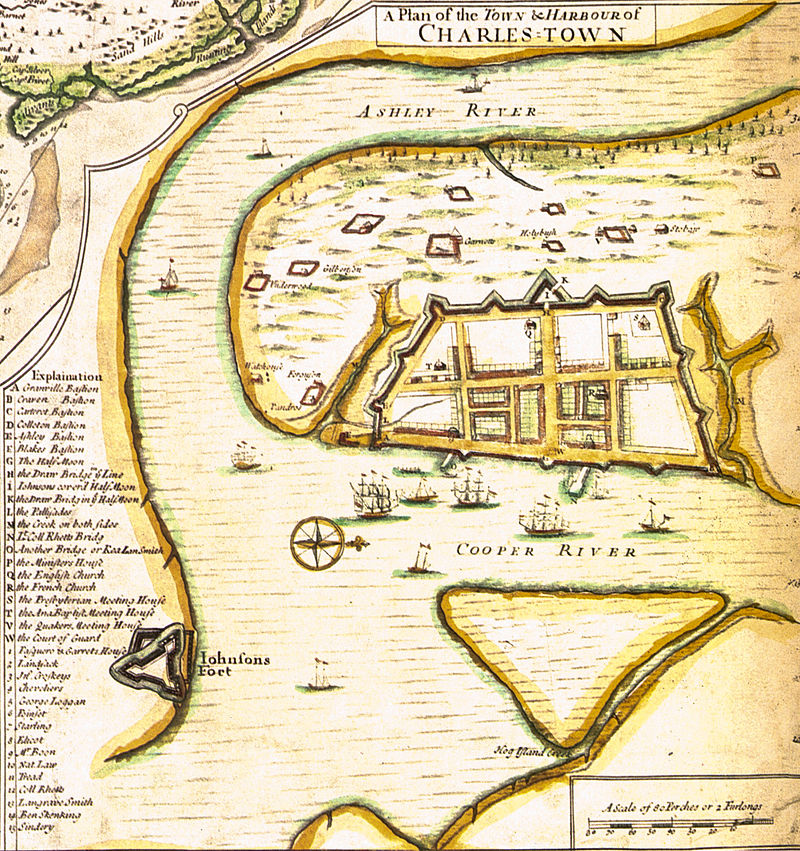
A map of Charles Town from the 17th century
One of these ships was the Crowley and Blackbeard decided to take all the crew and passengers as prisoners. This seemed a brazen and cruel act, but Blackbeard had requested medicine for his crew. He demanded a chest of it be exchanged for the hostages and threatened that if he was not to receive it in the allotted time, all the prisoners would be killed, their heads sent to the governor and the captured ships burnt. When the government failed to pay up the goods in the allotted time, Blackbeard sailed his ships closer to the city and the citizens flew into a panic. Believing their town was going to be attacked, they began looting and fleeing. Blackbeard hadn’t done anything other than move his ships, but his name was so infamous that they truly believed he was capable of horrific deeds. The government quickly paid up and the prisoners were returned, sans their valuables and fine clothes, of course. Yet again Blackbeard had won, and he had done it all without spilling a drop of blood.
If Blackbeard wasn’t already notorious, his bold actions around the harbour of Charles Town did the trick. Blackbeard had the daring and gall to take on the most risky of adventures, and commit acts of piracy that other captains would never dream of. The elaborate show with the hostages, and the massive amount of goods he managed to plunder while near Charles Town filled the newspapers and turned him into a legend.
Soon after these events, Blackbeard sailed his fleet near the Topsail Inlet in North Carolina. While doing so, Queen Anne’s Revenge was grounded and abandoned on a sandbar. This may have been an accident, and it’s possible that Blackbeard was only planning to careen his ship to scrape the hulls. But, there is a chance it was intentional. His company was growing to a huge, practically unmanageable size, and he wished to ‘shave off the fat’ and, like always, he had a cunning plan to do so.
The news of a royal pardon travelled quickly among the pirates. It had been announced that a pardon would be given to all pirates who surrendered before 5 September 1718, but this only applied to crimes committed before 5 January. This would obviously leave Blackbeard at risk due to his actions in Charles Town. He had a trump card however – a gullible comrade who he could send away to obtain the pardon and see what happened. Nudged by Blackbeard, Stede Bonnet obliviously left the company in a small sailing boat to try his luck. He obtained his pardon and sailed back to Blackbeard to collect his ship and crew, for he intended to work for commissions now.
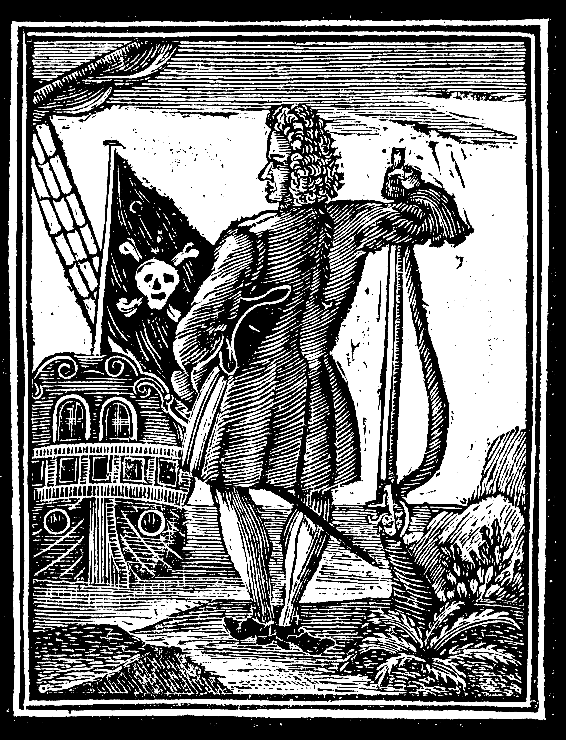
Stede Bonnet, as depicted in A General History of the Pyrates by Charles Johnson
However, the pirate Captain intended not only use Bonnet as a trump card, but also as his final scam. He stripped Bonnet’s ship, Revenge, of all its valuables and provisions and marooned the crew. Bonnet finally realised what Blackbeard was: not a friend, but a double-crossing snake. Hell-bent on revenge he reclaimed his crew and returned to piracy in a furious quest to hunt the betrayer. By then, Blackbeard had long disappeared into the fog and Bonnet and his crew were captured and hung for their crimes.
It was no wonder Bonnet couldn’t find the notorious pirate who cruelly deceived him. Blackbeard had returned to Bath town, sold all his newly obtained booty, bought a house and obtained a pardon. For all intents and purposes, this was the perfect chance for Teach to finally settle down, pardoned of his crimes and with more than enough money to retire on. There are even accounts of him marrying the daughter of a wealthy plantation owner. Blackbeard, however, was not the type who could settle down. His various misdemeanours at sea had not really been for wealth or a comfortable life, but more for the thrill of adventure and of conquest. Such a rush definitely could not be found settling down for a quiet life on land.
Blackbeard was given permission to become a privateer, but the lure of valuable merchant ships became too much to resist, and he returned to plundering and piracy. He did attempt to be covert about it, for example subduing the crew of two French ships, transferring them all to one and pretending he had ‘stumbled’ across the ‘deserted’ ship. For a while the governor believed him, sharing the cargo with Blackbeard. However, suspicions were raised when infamous pirates such as Charles Vane and Calico Jack stopped by his base on Ocracoke Island for impromptu gatherings.
News of the pirate parties spread quickly and the governor of Virginia, Alexander Spotswood, became worried about the dangerous crew drawing closer to his land. He issued a proclamation for all former pirates to give themselves up to the authorities, and forbade them from travelling in groups larger than three. Blackbeard, of course, declined the offer, and Spotswood decided to take a more direct approach. After obtaining information about Blackbeard’s location he sent Lieutenant Robert Maynard with two heavily armed ships and 57 men after the bearded scoundrel.
Just as expected, Maynard found the pirates anchored at Ocracoke Island, so he stopped any ships from entering the inlet and positioned lookouts to prevent Blackbeard escaping. The pirate commander, meanwhile, was completely unaware of Maynard’s presence. He was in the midst of hosting a party, and had no more than 25 sailors aboard with him. As soon as morning broke the two sloops moved and Blackbeard spotted them immediately, he cut the anchor, unfurled the sails and fired his guns on the two ships. It was a devastating blow that cost Maynard a huge number of his forces and one of the sloops was so badly damaged that it was out of commission for the rest of the battle.
After a flurry of fires, both remaining ships were grounded and the vessels drew close to each other. Seeing an opportunity, and knowing time was of the essence, Blackbeard ordered his men aboard Maynard’s virtually empty ship amid a hail of smoke and gunpowder. As he raced towards Maynard, huddled with a small group at the stern, the hold of the ship opened and a hoard of men burst out. Unbeknown to Blackbeard, they had been hiding there and the surprise attack dealt as much devastation as Maynard intended.
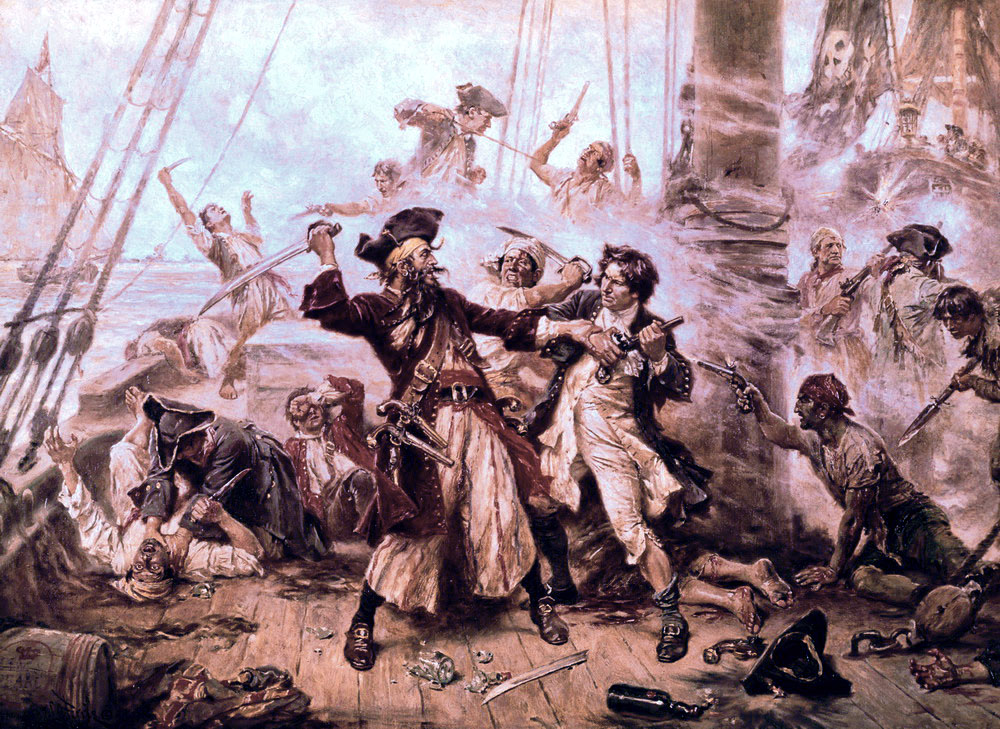
Unprepared for the flurry of men, Blackbeard’s pirates desperately fought under their leader’s rallying cry, but it was not enough. The pirates were pushed back to the bow and separated from their fearless leader. Alone, surrounded and exposed, Blackbeard fired his flintlock at Maynard who then did the same. They fought cutlass to sword, and the mighty pirate managed to break the Lieutenant’s blade. As Maynard hurried to load his gun, Blackbeard leapt forward to cut him down, but before he could do so, one of Maynard’s men slashed him across the neck. Staggering and losing blood, the crew leapt on him as one, attacking and finally draining the life out of the infamous demon of the seas.
When they examined Blackbeard’s body, they reportedly discovered it had been shot five times, and slashed around 20. His head was separated from his body, and his corpse thrown into the water, as if the men were terrified it would spring up and attack them again. His head, meanwhile, was hung from the bowsprit of Maynard’s sloop. Most of Blackbeard’s remaining crew joined their leader in death – hung and left to rot on gibbets in Gallows Road.
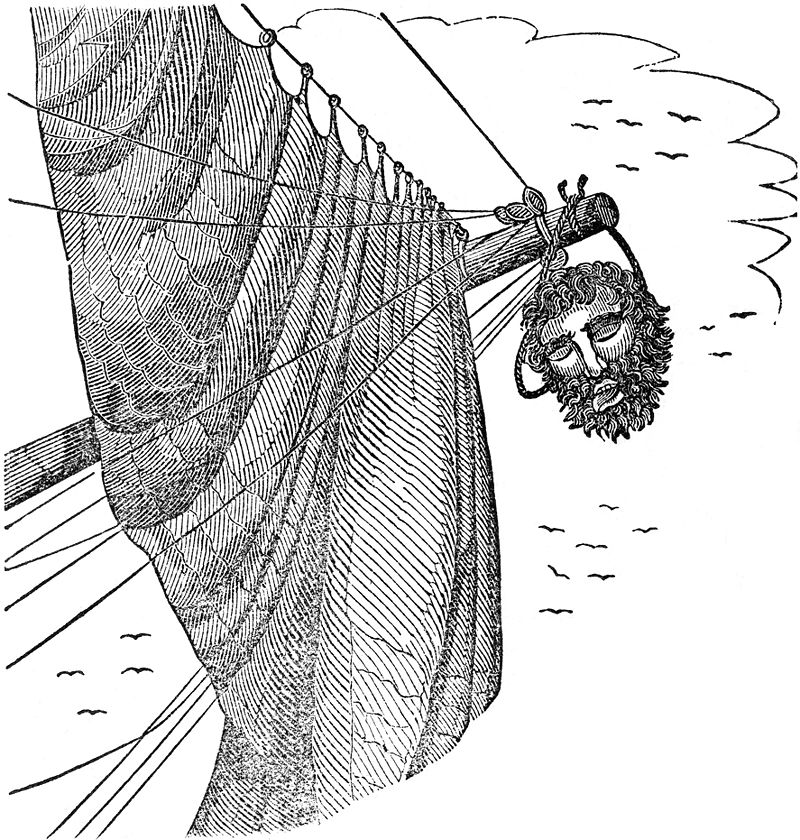
Blackbeard’s severed head hanging from Maynard’s ship
Blackbeard was far from the most successful pirates of his era; many others retired with fabulous riches, and there are numerous accounts of men who captured far more ships than he did. He left no hordes of treasure and his piracy ‘career’ lasted only a couple of years, but despite this he is, arguably, the most famous pirate captain, not only of the Caribbean, but of all time. His story and image have graced the pages of many books and he has featured in countless movies and stories. Tales of his lingering ghost, seeking out his lost head, have also been told for years, and there is a legend that his skull is now used as a drinking chalice. He did not gain this notoriety through success or riches, but by what he represented: the insatiable lust for adventure, the audacious nature to fight against insurmountable odds, and a mysterious, feared spectre of a devilish man. We do not know his true name, and we do not know his full story, but we do know what Blackbeard symbolises, even today, and that is the daring and intrepid spirit of piracy.